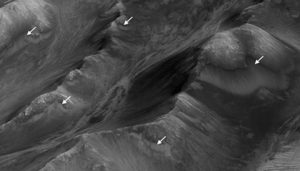Dark Streaks on Mars Revisited
New research on seasonal streaks in Martian canyons provides evidence against underground pools of water.

The white arrows point out the seasonal dark streaks, called recurring slope lineae (RSL), on the surface of Mars. The Valles Marineris region has the densest population of streaks on the Red Planet.
NASA / JPL-Caltech / University of Arizona
NASA / JPL-Caltech / University of Arizona
Since 2011, astronomers have seen dark streaks appear and fade on the surface of Mars. These dark streaks, called recurring slope lineae (RSL), show up on the planet’s steep slopes during the warmer months and fade during the colder months. This happens year after year.
Planetary scientists suspected brines were somehow involved (pure liquid water can’t survive on Mars’s surface). But no one really knew until last September, when Lujendra Ojha (Georgia Institute of Technology) and others confirmed that these warm-season features contain water-soaked salts.
Now, Matthew Chojnacki (University of Arizona) and other members of Ojha’s team have taken the next step in understanding these mysterious flows. They investigated thousands of streaks in 41 sites of the Valles Marineris region, the largest canyon system in the solar system. There the team found that pretty much all of the walls of the canyon system, including the sides of isolated peaks, had RSLs. “As far as we can tell, this is the densest population of them on the planet,” says Chojnacki in a press release.
If Ojha’s paper is saying, ‘blame salty water for RSL’, Chojnacki’s paper is saying, ‘Guys, they’re everywhere and not quite what we expected.’ Their work gave proof that underground pools of water weren’t responsible for RSL. Instead, it’s more likely that the water is coming from the atmosphere.
RSL and Liquid Water
Since their discovery, RSL have been a popular topic in planetary exploration and the strongest evidence of liquid water on Mars. One hypothesis for RSL formation that had people excited is that they form when underground bodies of salty water leak onto the surface. “[This] is exciting because those aquifers could be habitable environments for some very, very salt-hardy microbes,” says planetary scientist Briony Horgan (Purdue University), who wasn’t involved with the study.
Water could also become an important resource for humans living on the Red Planet. If RSL really are indicators of water, then it means humans may have access to water at least around the Valles Marineris region. This area stretches over 4,000 km (2,500 mi) across Mars, mostly east-west and just below the equator.
But the team found streaks on canyon ridges and even isolated peaks. “It's really hard to imagine how an aquifer could be sustained near the tops of isolated mountains, so this observation casts some doubt on that theory,” says Horgan.
RSL and the Martian Atmosphere
One alternative is that the salts on the Martian surface are pulling water from the atmosphere. This process is called deliquescence. Scientists have suggested it before to explain signs of water action on the Red Planet.
If the Martian atmosphere is a possible source of water, then there’s a slight issue with the math. Chojanacki’s team estimates that about 10 to 40 Olympic-sized swimming pools (30,000 to 100,000 cubic meters) of water are required to make the streaks. Based on orbiter estimates, there’s enough water vapor floating above Valles Marinies for that to happen, but researchers can’t think of an efficient way for the surface to extract that much water from the atmosphere.
On the other hand, if this amount of water is coming from the atmosphere, then maybe we’ve underestimated how much is there. “This could mean that there are places on Mars that are more humid than we realized, and that just maybe there's enough water in the atmosphere to serve as a resource for future human exploration,” says Horgan.
No comments:
Post a Comment